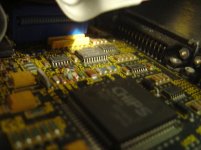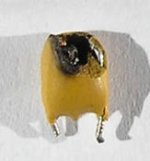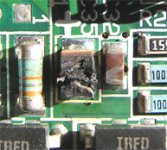Well, so the news are:
Firstly, I started with an inspection to the motherboard and all the tantalum and aluminum electrolytic capacitors seemed to be good.
As I had the computer turned off for several months, I opened the power supply. There was no sign of dust (happened the same in the motherboard): seems like it wasn't turn on a lot. I found out a aluminum electrolytic capacitor that had some strange stains that disappeared when I cleaned it with my finger.

I found out another aluminum electrolytic capacitor that wasn't straight, but I couldn't take a pic.
Finally, I removed the floppy and the hard drive (remaining connected the motherboard and the VGA card) and turned on the power supply. Everything happened as I said before.
http://www.youtube.com/watch?v=8E7X8d1l_KE
So I unplugged everything, remaining the power source at work and (I think) the fan had an odd behavior.
What do you think about this? Ah, and please, could you tell me how to do a clip test to a AT power supply?
Thank you for all the attention.
PS: the image that is attached at the end was a mistake, and I couldn't took it off.
Firstly, I started with an inspection to the motherboard and all the tantalum and aluminum electrolytic capacitors seemed to be good.
As I had the computer turned off for several months, I opened the power supply. There was no sign of dust (happened the same in the motherboard): seems like it wasn't turn on a lot. I found out a aluminum electrolytic capacitor that had some strange stains that disappeared when I cleaned it with my finger.

I found out another aluminum electrolytic capacitor that wasn't straight, but I couldn't take a pic.
Finally, I removed the floppy and the hard drive (remaining connected the motherboard and the VGA card) and turned on the power supply. Everything happened as I said before.
http://www.youtube.com/watch?v=8E7X8d1l_KE
So I unplugged everything, remaining the power source at work and (I think) the fan had an odd behavior.
What do you think about this? Ah, and please, could you tell me how to do a clip test to a AT power supply?
Thank you for all the attention.
PS: the image that is attached at the end was a mistake, and I couldn't took it off.
Attachments
Last edited:



